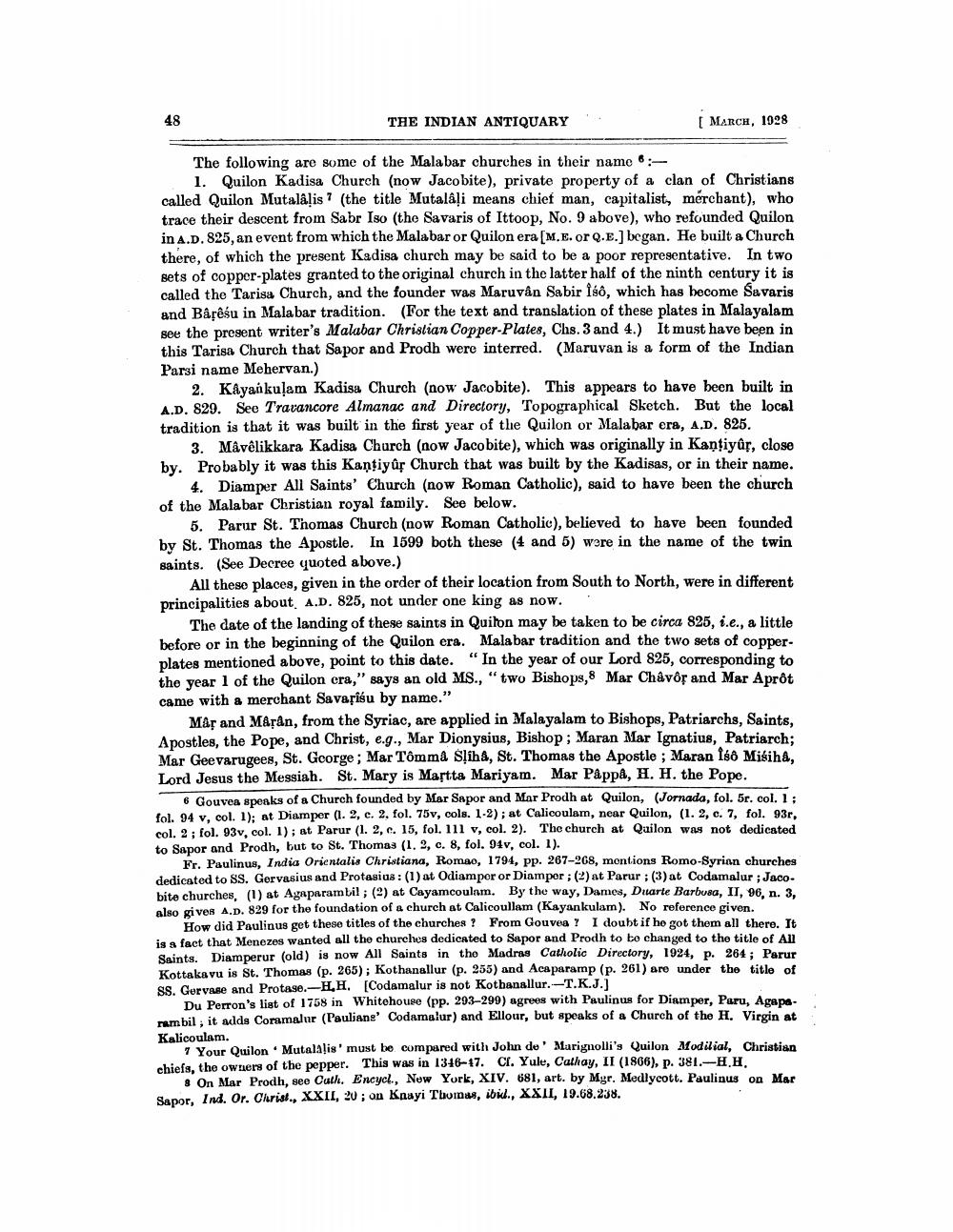________________
THE INDIAN ANTIQUARY
[ MARCH, 1928
The following are some of the Malabar churches in their name 6:
1. Quilon Kadisa Church (now Jacobite), private property of a clan of Christians called Quilon Mutaláļis 7 (the title Mutaláļi means chiet man, capitalist, merchant), who trace their descent from Sabr Iso (the Savaris of Ittoop, No. 9 above), who refounded Quilon in A.D. 825, an event from which the Malabar or Quilon era (M.E.or Q.E.] began. He built a Church there, of which the present Kadisa church may be said to be a poor representative. In two sets of copper-plates granted to the original church in the latter half of the ninth century it is called the Tarisa Church, and the founder was Maruvân Sabir 148, which has become Savaris and Barēsu in Malabar tradition. (For the text and translation of these plates in Malayalam see the present writer's Malabar Christian Copper-Plates, Chs. 3 and 4.) It must have been in this Tarisa Church that Sapor and Prodh were interred. (Maruvan is a form of the Indian Parsi name Mehervan.)
2. Kâyankuļam Kadisa Church (now Jacobite). This appears to have been built in A.D. 829. See Travancore Almanac and Directory, Topographical Sketch. But the local tradition is that it was built in the first year of the Quilon or Malabar era, A.D. 825.
3. Mâvêlikkara Kadisa Church now Jacobite), which was originally in Kantiyûr, close by. Probably it was this Kantiyûr Church that was built by the Kadisas, or in their name.
4. Diamper All Saints' Church (now Roman Catholic), said to have been the church of the Malabar Christian royal family. See below.
5. Parur St. Thomas Church (now Roman Catholic), believed to have been founded by St. Thomas the Apostle. In 1599 both these (4 and 5) were in the name of the twin saints. (See Decree quoted above.)
All these places, given in the order of their location from South to North, were in different principalities about A.D. 825, not under one king as now.
The date of the landing of these saints in Quilon may be taken to be circa 825, i.e., a little before or in the beginning of the Quilon era. Malabar tradition and the two sets of copperplates mentioned above, point to this date. “In the year of our Lord 825, corresponding to the year 1 of the Quilon cra," says an old MS., "two Bishops,8 Mar Chavor and Mar Aprôt came with a merchant Savarisu by name."
Mâț and MAșan, from the Syriac, are applied in Malayalam to Bishops, Patriarchs, Saints, Apostles, the Pope, and Christ, e.g., Mar Dionysius, Bishop; Maran Mar Ignatius, Patriarch; Mar Geevarugees, St. George; Mar Tomma Sliha, St. Thomas the Apostle ; Maran 166 Misiha, Lord Jesus the Messiah. St. Mary is Martta Mariyam. Mar Pappa, H. H. the Pope.
6 Gouves speaks of a Church founded by Mar Sapor and Mar Prodh at Quilon, (Jornada, fol. 5r. col. 1 ; fol. 94 v, col. 1); at Diamper (1. 2, c. 2, fol. 75v, cols. 1-2); at Calicoulam, near Quilon, (1. 2, c. 7, fol. 93r, col. 2, fol. 93v, col. 1): at Parur (1. 2, c. 15, fol. 111 y, col. 2). The church at Quilon was not dedicated to Sapor and Prodh, but to St. Thomas (1.2, c. 8, fol. 94v, col. 1).
Fr. Paulinus, India Orientalis Christiana, Romao, 1794, PP. 267-268, montions Romo-Syrian churches dedicated to SS. Gorvasius and Protasius : (1) at Odiampor or Diamper ; (2) at Parur ; (3) at Codamalur; Jaco. bite churches, (1) at Agaparambil; (2) at Cayamcoulam. By the way, Dames, Duarte Barbuna, IT, 96, n. 3, Also giver A.D. 829 for the foundation of a church at Calicoullam (Kayankulam). No reference given.
How did Paulinus get these titles of the churches ? From GouveaY I doubt if he got thom all there. It is a fact that Menezes wanted all the churches dedicated to Sapor and Prodh to be changed to the title of All Sainte Diamperur (old) is now All Saints in tho Madras Catholic Directory. 1924. D. 264: Parur Kottakavu is St. Thomas (p. 265); Kothanallur (p. 255) and Acaparamp (p. 261) are under the title of SS. Gervase and Protase.-H,H, [Codamalur is not Kothanallur.-T.K.J.]
Du Perron's list of 1758 in Whitehouse (pp. 293–299) agrees with Paulinus for Diamper, Paru, Agaperambil, it adds Coramalur (Paulians' Codamalur) and Ellour, but speaks of a Church of the H. Virgin at Kalicoulam.
1 Your Quilon.Mutalalis' must be compared with John de' Marignolli's Quilon Modilial, Christian chiefs, the owners of the pepper. This was in 1346-17. C. Yule, Cathay, II (1866), p. 381.-H.H.
& On Mar Prodh, see Cath. Encycl., New York, XIV. 681, art. by Myr. Medlycott. Paulinus on Mar Sapor, Ind. Or. Christ., XXII, 20 ; on Knayi Tboinas, ibid., XXII, 19.68.238.




